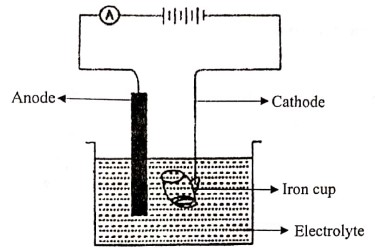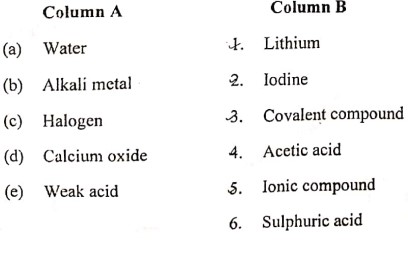Maximum Marks: 80
Time allowed: Two and half hours
Answers to this Paper must be written on the paper provided separately.
You will not be allowed to write during first 15 minutes.
This time is to be spent in reading the question paper.
The time given at the head of this Paper is the time allowed for writing the answers.
Section-A
(Attempt all questions from this Section.)
Question 1
Choose one correct answer to the questions from the given options:
(i) Unsaturated hydrocarbons undergo:
(a) Addition reaction
(b) Substitution reaction
(c) Oxidation reaction
(d) Redox reaction
Solution
View Solution
(ii) In the 2nd period Neon has maximum Ionization Potential because:
(a) It has unstable electronic configuration.
(b) It easily accepts electrons.
(c) It easily loses electrons.
(d) The outer most shell is completely filled.
Solution
View Solution
(iii) Copper, Zinc and Tin are the metals alloyed to form:
(a) Duralumin
(b) Brass
(c) Bronze
(d) Solder
Solution
View Solution
(iv) The metal hydroxide which reacts with both acids and alkalis to form salt and water is:
(a) Calcium hydroxide
(b) Magnesium hydroxide
(c) Aluminium hydroxide
(d) Ferric hydroxide
Solution
View Solution
(v) Reaction of an alcohol with a carboxylic acid in the presence of concentrated H2SO4
is termed as:
(a) Halogenation
(b) Esterification
(c) Hydrogenation
(d) Dehydrohalogenation
Solution
View Solution
(vi) Conversion of Ethanol to Ethene by the action of concentrated sulphuric acid invoives:
(a) Dehydration
(b) Dehydrogenation
(c) Dehydrohalogenation
(d) Hydrolysis
Solution
View Solution
(vii) The oxidizing agent in the equation S + 2H2SO4 → 3SO2 + 2H2O is:
(a) Sulphur
(b) Sulphuric acid
(c) Sulphur dioxide
(d) Water
Solution
View Solution
(viii) Electron Affinity is maximum in:
(a) Mg
(b) Ar
(c) Li
(d) Br
Solution
View Solution
(ix) The compound that is not a constituent of the electrolytic mixture used in the
Hall-Heroult’s process is:
(a) Al2O3
(b) NaAlO2
(c) Na3AlF6
(d) CaF2
Solution
View Solution
(x) On passing ammonia gas over heated copper oxide for some time, a reddish-brown
residue is left behind. What property of ammonia is demonstrated here?
(a) Basic property
(b) Oxidising property
(c) Reducing property
(d) Acidic property
Solution
View Solution
(xi) Rotten egg smell is due to the liberation of:
(a) HCl gas
(b) H2S gas
(c) Cl2 gas
(d) SO2 gas
Solution
View Solution
(xii) Ammonia gas is collected by downward displacement of air since ammonia is:
(a) very slightly soluble in water.
(b) heavier than air.
(c) lighter than air.
(d) insoluble in water.
Solution
View Solution
(xiii) Which of the following would occupy 22.4 litres at S.T.P.?
1. 32g of oxygen gas
2. 2 moles of hydrogen gas
3. 6.022 x 1023 molecules of ammonia
(a) 1 & 2
(b) 1 & 3
(c) 2 & 3
(d) 1, 2 & 3
[Atomic weights: O =16, H=1, N = 14]
Solution
View Solution
(xiv) In the molecule of water, oxygen atom has:
(a) One shared pair of electrons.
(b) Three shared pairs of electrons.
(c) Two lone pairs of electrons.
(d) One lone pair of electrons.
Solution
View Solution
(xv) A mineral from which the metal can be extracted economically and conveniently is
known as:
(a) Matrix
(b) Ore
(c) Flux
(d) Alloy
Solution
View Solution
Question 2
Section-B
(Attempt any four questions from this Section.)
Question 3
Rewrite the following statements by adding the correct word as shown in the
example:

(a) Sulphuric acid acts as a dehydrating agent.
(b) Ammonia reacts with chlorine to give ammonium chloride and nitrogen.
(ii) Identify only the anion present in the following compound:
(a) The compound on heating produces a colourless, odourless gas which turns
lime water milky and has no effect on acidified potassium dichromate solution.
(b) The solution of the compound which on treating with concentrated sulphuric
acid and freshly prepared ferrous sulphate solution produces a brown ring.
(iii) Mohan has three solutions P, Q and R having a pH of 13, 5 and 2 respectively.
Which of the above solutions P, Q or R:
(a) will react with Magnesium to liberate hydrogen gas?
(b) will liberate ammonia gas when it reacts with ammonium chloride?
(c) will contain molecules as well as ions?
(iv) The following table is related to an Industrial process of an acid.

Identify (a), (b) and (c).
Solution
View Solution
Question 4
(i) Define the following terms:
(a) Molar volume
(b) Normal salt
(ii) Draw the electron dot structure of:
(a) Methane molecule
(b) Nitrogen molecule
[Atomic number: N=7,C= 6, H=1]
(iii) Complete and balance the following equations:

(iv) Choose the organic compound from the list given below to answer the following
questions:
Ethene, Ethanoic acid, Ethanol, Methanal
(a) The compound which does not have a double bond in its structure.
(b) The compound which in its pure form turns into an ice like solid on cooling.
(c) The compound which is used for artificial ripening of fruits.
Solution
View Solution
Question 5
(i) Name the main metal used in making of the alloys given below:
(a) Duralumin
(b) Stainless steel
(ii) Differentiate between the following pairs based on the criteria given:
(a) Sulphuric acid and Nitric acid (using barium chloride solution)
(b) Unsaturated and Saturated hydrocarbons (type of bond present)
(iii) Calcium carbonate reacts with dilute hydrochloric acid as given below:
CaCO3 + 2HCl → CaCl2 + H2O + CO3
(a) What is the mass of 5 moles of calcium carbonate? (Relative molecular mass of calcium carbonate is 100)
(b) How many moles of HCI will react with 5 moles of calcium carbonate?
(c) What is the volume of carbon dioxide liberated at S.T.P. at the same time?
(iv) Identify the gas evolved in each of the following reactions:
(a) Methane undergoes complete combustion.
(b) Copper carbonate is heated.
(c) MnO2 reacts with concentrated HCl.
Solution
View Solution
Question 6
(i)

From the above reactions X or Y, identify the reaction which exhibits;
(a) electrolytic dissociation
(b) ionization
(ii) Give reasons for the following:
(a) Inert gases do not form ions.
(b) Covalent compounds have a low melting and boiling point.
(iii) Arrange the following as per the instructions given in the brackets:
(a) Carbon, Fluorine, Beryllium (decreasing order of atomic size)
(b) Sulphuric acid, Phosphoric acid, Acetic acid (increasing order of number of replaceable H atoms per molecule)
(c) Potassium, Lithium, Sodium (increasing order of ionization potential)
(iv) Identify the following:
(a) An element in period 1 which can be placed in both group 1 and group 17 of the Periodic Table.
(b) The element having electronic configuration 2, 8, 6.
(c) The most electronegative element of period 3.
Solution
View Solution
Question 7
(i) Rita was given an unknown salt for identification. She prepared a solution of the salt [2]
and divided it into two parts.
- To the first part of the salt solution, she added a few drops of ammonium
hydroxide and obtained a reddish-brown precipitate.
- To the second part of the salt solution, she added a few drops of silver nitrate
solution and obtained a white precipitate.
Name:
(a) the cation present and
(b) the anion present in the salt given for identification.
(ii) Fill in the blanks by choosing the correct answer from the bracket:
(a) Carbon tetrachloride is a _____ [polar / non-polar ] covalent molecule.
(b) During electrolysis of acidulated water, the gas liberated at the anode is ____
[oxygen / hydrogen].
(iii) Ammonia burns in Oxygen as shown below.
4NH3 + 3O2 → 2N2 + 6H2O
If 240 cc of ammonia is burnt in 300 cc of oxygen, find out the composition of the resultant gaseous mixture at room temperature.
(iv) The following table shows the electronic configuration of the atoms A, B, C and D.

(a) Write the formula of the compound formed between:
1. A and B
2. D and C
(b) Which of the above elements will exhibit catenation?
Solution
View Solution
Question 8
(i) Choose the correct answer from the list given below:
[zinc blende, C2H2, calamine, CH, haematite]
(a) The ore which can be concentrated by magnetic separation.
(b) Empirical formula of Ethyne.
(ii) Give balanced equation for the following reactions:
(a) Copper reacts with concentrated Nitric acid.
(b) Aluminium nitride is treated with warm water.
(iii) Match the salts underlined in Column A with the most suitable method of
preparation given in Column B.

(iv)
Hydrogen chloride gas is prepared in the laboratory by the action of concentrated sulphuric acid on sodium chloride.
(a) Give balanced chemical equation for the above reaction.
(b) State the method of collection of the gas formed above.
(c) What is the property of sulphuric acid that makes it a suitable reagent for the reaction?
Solution
View Solution








